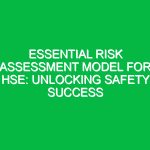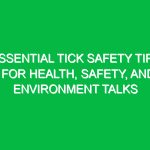Introduction
In the ever-evolving landscape of Workplace Safety, the importance of an effective risk assessment policy cannot be overstated. A risk assessment policy serves as a foundational framework for organizations aiming to protect their employees, comply with legal Regulations, and promote a culture of Safety within the Health, Safety, and Environment (HSE) domain. Understanding what constitutes a risk assessment policy and its relevance is crucial for any organization striving for success in Safety management.
At its core, a risk assessment policy outlines the Procedures and guidelines for identifying, evaluating, and mitigating risks that could potentially harm individuals or the environment. This policy not only safeguards employees but also enhances operational efficiency by minimizing disruptions caused by accidents or safety incidents. In this article, we will explore the essential components of a risk assessment policy, its implementation, and its significant role in ensuring a safe working environment.
Understanding Risk Assessment Policy
A risk assessment policy can be defined as a documented statement that outlines the organization’s approach to identifying and managing risks. It includes the methods used to assess risks, the responsibilities of personnel, and the protocols for communicating findings and implementing Control Measures. The policy acts as a guiding document that shapes the organization’s safety culture and provides a systematic approach to risk management.
In the HSE context, a robust risk assessment policy is integral to fostering a proactive approach to safety. By systematically evaluating potential Hazards, organizations can prioritize risks and allocate resources effectively. This not only helps in compliance with legal requirements but also builds trust among employees, stakeholders, and the community, demonstrating a commitment to health and safety.
Key Aspects of a Risk Assessment Policy
1. Identification of Hazards
The first step in any risk assessment policy is the identification of potential hazards. Hazards can come in various forms, including physical, chemical, biological, ergonomic, and psychosocial. For example, in a manufacturing facility, hazards may include machinery that poses a risk of injury, exposure to harmful substances, or ergonomic challenges like repetitive strain injuries.
Organizations must employ various techniques to identify hazards, such as workplace inspections, employee feedback, incident reporting, and reviewing past accidents. A comprehensive approach ensures that all potential risks are accounted for, forming the basis for effective risk management strategies.
2. Risk Evaluation
Once hazards are identified, the next critical aspect is evaluating the associated risks. This involves determining the likelihood of an incident occurring and the potential consequences if it does. Organizations often use a risk matrix to classify risks based on their severity and likelihood, allowing them to prioritize which risks require immediate attention.
For instance, a chemical spill may have a high likelihood of occurrence in a laboratory setting, with severe consequences for employee health and the environment. By evaluating such risks, organizations can focus their resources on implementing Control Measures that mitigate the most pressing threats.
3. Implementation of Control Measures
After evaluating risks, organizations must develop and implement control measures to mitigate them. Control measures can include engineering solutions, administrative controls, personal protective equipment (PPE), and Training programs. The goal is to reduce the likelihood of incidents or minimize their impact.
For example, in a construction site, implementing Fall Protection systems, conducting regular safety training, and ensuring proper use of PPE are essential steps in safeguarding workers from potential hazards. Moreover, organizations should continuously review and update control measures to adapt to changing circumstances and emerging risks.
4. Monitoring and Review
A risk assessment policy should not be static; it requires ongoing monitoring and periodic reviews. Regularly evaluating the effectiveness of control measures and adjusting them as necessary is vital for maintaining a safe workplace. This can involve conducting follow-up assessments, analyzing incident reports, and seeking employee feedback.
An effective monitoring process ensures that organizations remain vigilant against new hazards that may arise over time. It also demonstrates a commitment to continuous improvement in health and safety practices.
5. Communication and Training
Effective communication is a cornerstone of any successful risk assessment policy. Organizations must ensure that all employees are aware of potential hazards and understand the procedures for reporting risks and incidents. Training sessions should be conducted regularly to educate employees on safety protocols and the importance of adhering to the risk assessment policy.
For instance, a company may implement a training program that educates employees on how to recognize hazards in their work environment and the steps to take in case of an emergency. This empowers employees to play an active role in maintaining a safe workplace.
Benefits of a Comprehensive Risk Assessment Policy
Implementing a comprehensive risk assessment policy offers numerous Benefits to organizations, including:
- Enhanced Safety: A well-defined policy reduces the likelihood of accidents, injuries, and illnesses in the workplace.
- Legal Compliance: Organizations that adhere to risk assessment policies are better positioned to comply with local and international health and safety regulations.
- Cost Savings: By preventing accidents and incidents, organizations can save on medical expenses, legal fees, and lost productivity.
- Improved Reputation: Demonstrating a commitment to health and safety enhances an organization’s reputation among employees, clients, and the public.
- Employee Engagement: Involving employees in the risk assessment process fosters a culture of safety and encourages them to take ownership of their well-being.
Best Practices for Developing a Risk Assessment Policy
Creating an effective risk assessment policy requires a thoughtful approach. Here are some Best Practices to consider:
- Involve Employees: Engage employees at all levels in the development and implementation of the policy. Their insights can provide valuable perspectives on potential hazards.
- Tailor to Your Organization: Customize the risk assessment policy to reflect the specific needs and risks of your organization and industry.
- Use Clear Language: Write the policy using clear, straightforward language that is easily understood by all employees.
- Provide Resources: Ensure that employees have access to the necessary resources and training to effectively implement the policy.
- Regularly Update: Review and update the policy regularly to reflect changes in operations, regulations, or emerging risks.
Regulations and Standards Governing Risk Assessment Policy
Compliance with regulations and standards is a crucial aspect of developing a risk assessment policy. Various laws and guidelines govern Workplace Safety across the globe. In the United States, the Occupational Safety and Health Administration (OSHA) mandates that employers conduct regular risk assessments to identify and mitigate hazards in the workplace. In the United Kingdom, the Health and Safety Executive (HSE) outlines guidelines for risk assessment under the Health and Safety at Work Act.
These regulations emphasize the importance of risk assessments in promoting health and safety and provide a framework for organizations to develop their policies. Failure to comply with these regulations can result in severe penalties, including fines and legal repercussions.
Conclusion
In conclusion, a well-structured risk assessment policy is essential for any organization operating within the HSE domain. It serves as a proactive measure to identify, evaluate, and mitigate risks, ultimately promoting a culture of safety and compliance. By investing in a comprehensive risk assessment policy, organizations can enhance employee safety, reduce costs, and improve their overall reputation.
As we move forward, it is crucial for organizations to recognize the dynamic nature of risks and maintain a commitment to continuous improvement in their safety practices. By doing so, they not only protect their employees and the environment but also unlock the potential for safety success in the workplace. Embracing a robust risk assessment policy is not just a regulatory requirement; it is a moral imperative that benefits everyone involved.


